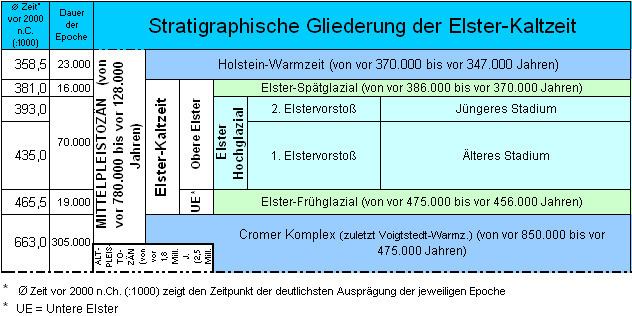 | ||
The Cromerian Stage or Cromerian Complex, also called either the Cromerian, Cromerian interglacial, (German: Cromerium) or, rarely the Cromerian warm period (Kromer-Warmzeit or Cromer-Warmzeit), is a stage consisting of multiple glacial and interglacial periods in the Middle Pleistocene epoch. It is named after the East Anglian town of Cromer in England where interglacial deposits that accumulated during part of this stage were first discovered. The stratotype for this interglacial is the 'Cromer Forest Bed' situated at the bottom of the coastal cliff near West Runton (East Anglia). The 'British' Cromerian with the rank of a stage forms part of the superstage that is known as the Cromerian Complex in Europe. In Central Europe, the Cromerian Complex (Cromer-Komplex) is divided into three glacials and four interglacials, which are equivalent to Marine Isotope stages 13 to 21. In the Alpine region it may also be referred to as the Günz-Mindel interglacial, the warm period between the Günz and Mindel glaciations. In Britain, sediments deposited during the Cromerian (s.s.) precede those of the Anglian Stage and are on top of Beestonian Stage sediments. In the British isles several interglacials of 'Cromerian affinity' are known from this timeframe, one of these is the type Cromerian. Opinions of the exact correlation of British and continental Cromerian differ. Based upon the beginning of Marine Isotope Stage 21 and the end of Marine Isotope Stage 13, the Cromerian Complex started 866,000 years ago and ended 478,000 years ago.
The Cromerian (s.s.) had been equated to the Aftonian in North America. However, the Aftonian, along with the Yarmouthian (Yarmouth), Kansan, and Nebraskan, have been abandoned by North American Quaternary geologists and merged into the Pre-Illinoian. At this time, the Cromerian is correlated with the period of time, which includes the Pre-Illinoian C, Pre-Illinoian D, and Pre-Illinoian E glaciations of North America.
Proposals for structuring the Cromerium complex have become quite confusing. Great potential for a full breakdown has been provided by the extensive, continental series at Gorleben.
In 1990 a mammoth skeleton was found at West Runton; the best example of the species Mammuthus trogontherii to be unearthed so far.
A significant fossil site, with animal remains dating to the Cromer Complex, is the Mosbach Sands, named after an abandoned village near Wiesbaden. These fossils are about 600,000 years old.
